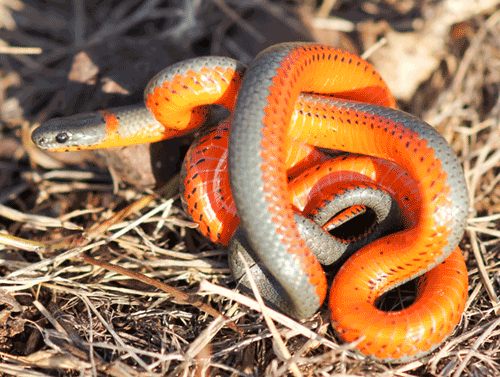
Today, the U.S. Fish and Wildlife Service (Service) proposed to list two snake species, the Key ring-necked snake (Diadophis punctatus acricus) and the rim rock crowned snake (Tantilla oolitica), as endangered under the Endangered Species Act (ESA). The Service also proposed to designate critical habitat for these nonvenomous snakes, including approximately 2,604 acres in Monroe County and approximately 5,972 acres in Miami-Dade County and Monroe County, Florida for the Key ring-necked snake and rim rock crowned snake, respectively. The proposal comes as a result of a petition and lawsuit filed by the Center for Biological Diversity earlier in 2022.
The Key ring-necked snake is a small, slender snake averaging 6-10 inches in length. This snake can be identified by its grayish-black dorsal surface and yellow, orange, or bright red abdomen, which fades to orange/red underneath its tail. Historically, the snake’s habitat is limited to pine rocklands and rockland hammocks in the Florida Keys. The species requires a moist microhabitat near fresh water.
The rim rock crowned snake is slightly smaller, ranging from 7-9 inches in length. This slender snake can be identified by its black head and its tan or beige body. As a mostly fossorial (underground) species, the rim rock crowned snake typically inhabits shallow soil, rocks, and stumps. Its habitat spans from the lower Florida Keys in the south to Miami-Dade County in the north.
According to the Federal Register notice, due to the cryptic and fossorial nature of the ring-necked and rim rock snakes, there is limited information available concerning the species’ population and demographics. As such, the Service based its assessment of each snake on the condition of its habitat as a proxy. The Service stated that the primary threats to the snakes include urban and agricultural development throughout the Florida Keys, which have fragmented the species’ limited habitats. The snakes also face concurrent habitat threats from fire suppression and sea level rise driven by climate change. Due to the snakes’ limited population range, these species experience low resiliency and are especially susceptible to further habitat loss.
As a consequence of shrinking habitats and limited resiliency, the Service concluded that each snake warrants listing as an endangered species under the ESA.
The Federal Register notice states the proposed rule will be open for comments until December 13, 2022. The Federal Register notice and supporting documents are available at regulations.gov, under Docket Number FWS-R4-ES-2022-0022.
- Associate
Sam Savoni focuses her practice on a variety of environmental and land use matters, including those dealing with the Endangered Species Act, National Environmental Policy Act, Clean Water Act, National Historic Preservation Act ...
Nossaman’s Endangered Species Law & Policy blog focuses on news, events, and policies affecting endangered species issues in California and throughout the United States. Topics include listing and critical habitat decisions, conservation and recovery planning, inter-agency consultation, and related developments in law, policy, and science. We also inform readers about regulatory and legislative developments, as well as key court decisions.
Stay Connected
 RSS Feed
RSS Feed
Categories
- Alternative Energy
- Bald and Golden Eagle Protection Act
- Budget
- CEQA
- CESA
- Climate Change
- Congress
- Conservation
- Construction Projects
- Consultation
- Continuing Education
- Court Decisions
- Critical Habitat
- Delisting
- Endangered Species Act
- Event
- Fish & Wildlife Service
- Freedom of Information Act
- Government Administration
- Legal
- Legislation
- Listing
- Litigation
- Migratory Bird
- National Marine Fisheries Service
- NEPA
- Off Shore Wind
- Pacific Northwest
- project
- Publications
- Regulatory Reform
- Sacramento-San Joaquin Delta
- SEPA
- Speaking Engagements
- Supreme Court
- Texas
- Timberland
- Water Issues

